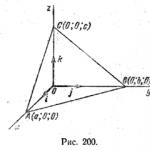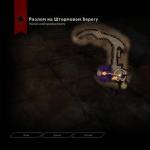This test will help you determine what is valuable and meaningful to you in life. You need to complete the following sentences. What you write may be important to you now or in the future. The main thing is that you are honest and sincere in your answers.
- I definitely have to...
- I definitely have to...
- I definitely have to...
- I definitely have to...
- I definitely have to...
- I definitely have to...
- It's terrible if...
- It's terrible if...
- It's terrible if...
- It's terrible if...
- It's terrible if...
- It's terrible if...
- I can't stand...
- I can't stand...
- I can't stand...
- I can't stand...
- I can't stand...
- I can't stand...
Interpretation of results
Determine which of the following values most of your answers belong to. It is these values that are of greatest interest to you now.
Freedom and justice in society
This is dissatisfaction with the state of society or a desire to make it better. Typical statements: “I cannot tolerate the mediocrity and lack of spirituality of the authorities,” “I cannot tolerate the existing lawlessness,” “I cannot tolerate indifferent bosses.”
Safety and Security
This is concern for your life and the life of your loved ones, fear of dangerous and unpredictable events that can happen in society: “It’s terrible if war starts,” “It’s terrible if evil triumphs,” “I definitely must be able to protect myself.”
Serving people
This is the desire to help and promote other people: “I must definitely help orphans,” “I must definitely make every effort to ensure that my students enter universities.”
The desire to have power over other people, to influence them, to command respect: “It’s terrible if they don’t consider me anything,” “It’s terrible if my colleagues stop respecting me,” “I must certainly be an authority in the eyes of my students.”
Fame, popularity, glory
The need to attract everyone's attention, to be a famous person, to arouse admiration: “It’s terrible if no one finds out about my talent,” “I must definitely leave my mark on history.”
Independence
This is the desire not to depend on others and their opinions, to decide everything in your life yourself: “It’s terrible if nothing depends on you,” “I can’t stand being told what to do,” “I absolutely must fulfill my plans.”
Material goods
The desire to have a good income, good living conditions, the opportunity to buy what you want: “It’s terrible if I live in a hostel all my life,” “I can’t stand it when my salary is delayed,” “I definitely have to find a well-paid job.”
Culture and self-education
The desire for spiritual improvement, love of art: “I absolutely must go to the opera,” “I cannot tolerate those who do not like classical literature.”
Kar energetic, professional and personal growth
High demands on oneself, the desire to be an excellent professional: “I can’t stand it when people do their job poorly,” “I definitely must achieve more than what I have now.”
Health
The desire to have good health, to get sick as little as possible, to lead a healthy lifestyle, to play sports: “It’s terrible if I get seriously ill,” “I can’t stand people who don’t care about their health,” “I definitely have to go in for sports.”
Love, family
The need to have close people, concerns about relationships with significant people: “It’s terrible if I’m left alone,” “It’s terrible if no one loves you,” “I definitely have to pay more attention to my husband and children.”
Attractiveness
The desire to have an attractive appearance, to follow fashion, to be satisfied with one’s appearance: “It’s terrible if a person doesn’t take care of himself,” “I definitely have to look good,” “I can’t stand unkempt men.”
Pleasures
Getting pleasure from such aspects of life as delicious food, drinks, sex, sleep, massage, etc.: “I definitely have to try everything in this life”, “I can’t stand old maids”, “It’s terrible if I can’t get enough sleep” .
Communication
The need to feel part of a group, to have a certain social circle, to meet new people, to make friends: “I can’t stand boring, unsociable people,” “It’s terrible if there are no friends at all.”
Spirituality, religiosity
The desire to live in accordance with one’s religious beliefs: “It’s terrible if I lose faith in God,” “I absolutely must go to church.”
Read the following questions, imagine the answers in your mind, and write down the FIRST thing that comes to your mind. Don't think about answers too long.
1. You are not alone. You are walking in the forest. Who are you hanging out with?
2. What does the forest look like? What kind of trees are around: coniferous or deciduous?
3. In the forest, you come out into a beautiful clearing and see a horse there. Describe it for yourself.
4. Do you walk with a horse and reach the river? How will you cross it? Sitting on a horse? Apart? Holding on to her/him?
5. Now they forgot about the horse. In front of you is an open field and a wall in the middle. Describe it: is it long or short? High or low? Are there doors?
— — — — — — — — — —
—
Interpretation:
1. The person you go with is the most important person in your life.
2. If there are a lot of people around you coniferous trees, then you feel that you are surrounded mostly by ill-wishers and enemies. If the forest is deciduous, then you are most likely friendly towards your immediate environment and treat everyone with confidence.
3. The horse describes your ideal of the opposite sex.
4. The way you cross the river testifies to your attitude towards people and especially towards your loved one. If you imagined that you were riding a horse, you are dominated by a selfish attitude towards your friends and partner, and the desire to dominate. If you walk separately, this indicates your fear of getting close to people, distrust and detachment from your partner. If you hold a horse/knight and walk next to him, this indicates a trusting and equal relationship in your couple.
5. The wall symbolizes how you see the problems in your life... hence everything that follows: if the wall is seen as long and without doors, then your problems seem insurmountable to you, if the wall is of moderate size and there are loopholes, then the problems seem feasible to you.
Source: Journal of Applied Psychology. N 4, 2001.- P. 9-30.
The technique arose as a result of the use and further improvement of I. G. Senin’s technique.
This technique is called “Morphological test life values"(MTLC), based on the goals and objectives of the study - determining the motivational and value structure of the individual.
The main diagnostic construct of MTLC is terminal values. By the term “value”, the authors of the methodology understand the subject’s attitude to a phenomenon, life fact, object and subject, and recognition of it as important, of vital importance.
List of life values diagnosed by MTLC:
Self development
Spiritual satisfaction
Creativity
Active social contacts
Own prestige
High financial position
Achievement
Preserving your own individuality.
The questionnaire is aimed at studying a person’s individual value system in order to better understand the meaning of his action or deed.
The morphological test of life values consists of 112 statements, each of which the subject must evaluate using a 5-point system.
If the meaning of the statement does not matter to you, then put the number 1 in the corresponding cell of the form;
If it is of little importance to you, then put the number 2;
If it has a certain meaning for you, put the number 3;
If this is IMPORTANT for you, put the number 4;
If this is VERY IMPORTANT for you, put the number 5.
To obtain primary test results, the answer scores are summed up in accordance with the key. After calculations, all results are entered into a table. The proposed values belong to multidirectional groups: spiritual and moral values and egoistic-prestigious (pragmatic) values. This is conceptually important for determining the direction of activity of an individual or group. The first include: self-development, spiritual satisfaction, creativity and active social contacts, reflecting a moral and business orientation. Accordingly, the second subgroup of values includes: prestige, achievements, financial situation, preservation of individuality. They, in turn, reflect the egoistic-prestigious orientation of the individual.
Approximate testing time is 20-30 minutes. Group form.
Schwartz Values Questionnaire
Source: Karandashev V.N. Schwartz's method for studying personal values. Concept and methodological guidance - St. Petersburg: Rech, 2004.
The Schwartz questionnaire is based on the theory that all values are divided into social and individual. The questionnaire was developed by Shalom Schwartz in 1992. When developing the questionnaire, the author used Rokeach’s methodology, qualitatively modifying, expanding and improving its conceptual basis.
Age: from 14 years old
The first part of the questionnaire is designed to study the values, ideals and beliefs that influence the individual. The list of values consists of two parts: nouns and adjectives, including 57 values. The subject evaluates each of the proposed values on a scale from 7 to -1 points. The second part of the Schwartz questionnaire is a personality profile. Consists of 40 descriptions of a person, characterizing 10 types of values. To evaluate descriptions, a scale from 4 to -1 points is used.
Questionnaire of Terminal Values (OTeV) by I. G. Senin
Source: Tikhomirov A.V. Method of differentiation of professional choices in the practice of career counseling/A. V. Tikhomirov // Personnel-profi Ekaterinburg, 2001. - Issue 2, part 1.
The test is based on the theoretical principles of M. Rokeach about the structure of human values. The technique allows you to assess the overall expression of each of the eight terminal values: personal prestige, high financial status, creativity, active social contacts, self-development, achievements, spiritual satisfaction, preservation of one’s own individuality. And also their representation in various spheres of human life: the sphere of professional life, the sphere of training and education, the sphere family life, sphere public life, sphere of hobbies.
The questionnaire consists of 80 statements, each of which the subject evaluates on a 5-point Lickert scale (1 - not at all important, 2 - of little importance, 3 - of some importance, 4 - important, 5 - very important). The obtained scores in points according to the norm tables are converted into stans. The results are presented in the form of an individual profile, separately for the scales of terminal values and life spheres.
Orekhova’s “Houses” technique
O. A. Orekhova created a projective test of personal relationships, social emotions and value orientations“Houses” (Orekhova, 2002, 2008, 2010). The “Houses” test was developed by child psychologist O.A. Orekhova. as a diagnostic tool for differentiating the emotional sphere of a child. The created methodology is based on the color-associative experiment proposed by A.M. Etkind. for relationship analysis. As a result of testing, a reliable picture emerges individual characteristics, preferences, cognitive needs and spiritual values, the ability to form relationships in society, options for personal development are revealed, psychological problems child and the presence of internal contradictions.
Psychological diagnostics are carried out in the form of group and individual sessions. The study procedure consists of three coloring tasks. In the first task, the child ranks six colors according to the degree of preference for each color. In the second task, the child is asked to choose the appropriate color for the houses in which feelings “live” (happiness, grief, justice, resentment, friendship, quarrel, kindness, anger, boredom, admiration). In the third task, the child’s color-associative range of emotions is connected to various types activities in kindergarten, to the very kindergarten which the child attends. When coloring the last house in the third task, the child independently chooses for himself social object preferences, chooses an activity for him and only then paints it in a suitable color, thus indicating his attitude to a given value, i.e. rank.
« Comprehensive study self-esteem and value orientations” by I. P. Shakhova
Children from preschool age.
In this case, the examination is carried out purely individually. The stimulus material consists of a card with a schematic image of three figures of children and seven cards with value characteristics printed on them. The psychologist invites the child to look at one card depicting three figures of children, under which there is another card with definitions, and answer the question: “Here are three very similar boys (girls). This boy is smart, this one is strong, this one is healthy. In all other respects they are no different. Which of these boys (girls) would you most like to be?” Etc. The child’s answer is encoded on the protocol form. Then the child must answer the following question: “Now imagine that one of these boys is really you. Who could it be? Which one of them is actually most like you?” The results are entered respectively in the columns “Value orientations” and “Self-esteem” (Shakhova, 1998). This technique considers such values as intelligence, strength, cheerfulness, beauty, neatness, success in learning, and health. In accordance with the results of this test, the psychologist can judge personal maturity the child, the differentiation of the system of value orientations, the assessment of the child’s personality by significant adults, and his adaptive capabilities.
“Determination of the formation of value orientations” Kruglov
This technique by B. S. Kruglov, an adapted and modified version of M. Rokeach’s technique, is aimed at identifying the level of formation of value orientations of younger schoolchildren.
Life values- these are ideals, concepts, faith, beliefs, principles, aspirations and other abstract aspects that are most significant to you. These values serve as guidelines in life, standards, criteria for the quality of life and the “correctness” of decisions and actions.
This psychological test of 18 simple, unfinished sentences, will help you determine what is valuable and meaningful to you in life.
Before starting the test, prepare a blank sheet of paper and a pen. Have you prepared? Then you can start.
You need to complete the following sentences. What you write may be important to you now or in the future. The main thing is that you are honest and sincere in your answers.
Online test questions:
1. I absolutely must...
2. I absolutely must...
3. I absolutely must...
4. I absolutely must...
5. I definitely must...
6. I absolutely must...
7. It’s terrible if...
8. It’s terrible if...
9. It’s terrible if...
10. It’s terrible if...
11. It’s terrible if...
12. It’s terrible if...
13. I can’t stand...
14. I can’t stand...
15. I can’t stand...
16. I can’t stand...
17. I can’t stand...
18. I can’t stand...
Answers: Decoding the test
All your answers are nothing more than an illustration of your values and ideals. Here's how to analyze them:
INTERPRETATION OF RESULTS
Determine which of the following values most of your answers belong to. It is these values that are of greatest interest to you now.
Freedom and justice in society
This is dissatisfaction with the state of society or a desire to make it better. Typical statements: “I cannot tolerate the mediocrity and lack of spirituality of the authorities,” “I cannot tolerate the existing lawlessness,” “I cannot tolerate indifferent bosses.”
Safety and Security
This is concern for your life and the life of your loved ones, fear of dangerous and unpredictable events that can happen in society: “It’s terrible if war starts,” “It’s terrible if evil triumphs,” “I definitely must be able to protect myself.”
Serving people
This is the desire to help and promote other people: “I must definitely help orphans,” “I must definitely make every effort to ensure that my students enter universities.”
The desire to have power over other people, to influence them, to command respect: “It’s terrible if they don’t consider me anything,” “It’s terrible if my colleagues stop respecting me,” “I must certainly be an authority in the eyes of my students.”
Fame, popularity, glory
The need to attract everyone's attention, to be a famous person, to arouse admiration: “It’s terrible if no one finds out about my talent,” “I must definitely leave my mark on history.”
Independence
This is the desire not to depend on others and their opinions, to decide everything in your life yourself: “It’s terrible if nothing depends on you,” “I can’t stand being told what to do,” “I absolutely must fulfill my plans.”
Material goods
The desire to have a good income, good living conditions, the opportunity to buy what you want: “It’s terrible if I live in a hostel all my life,” “I can’t stand it when my salary is delayed,” “I definitely have to find a well-paid job.”
Culture and self-education
The desire for spiritual improvement, love of art: “I absolutely must go to the opera,” “I cannot tolerate those who do not like classical literature.”
Career, professional and personal growth
High demands on oneself, the desire to be an excellent professional: “I can’t stand it when people do their job poorly,” “I definitely must achieve more than what I have now.”
Health
The desire to have good health, to get sick as little as possible, to lead a healthy lifestyle, to play sports: “It’s terrible if I get seriously ill,” “I can’t stand people who don’t care about their health,” “I definitely have to go in for sports.”
Love, family
The need to have close people, concern about relationships with significant people: “It’s terrible if I’m left alone,” “It’s terrible if no one loves you,” “I definitely have to pay more attention to my husband and children.”
Attractiveness
The desire to have an attractive appearance, to follow fashion, to be satisfied with one’s appearance: “It’s terrible if a person doesn’t take care of himself,” “I definitely have to look good,” “I can’t stand unkempt men.”
Pleasures
Getting pleasure from such aspects of life as delicious food, drinks, sex, sleep, massage, etc.: “I definitely have to try everything in this life”, “I can’t stand old maids”, “It’s terrible if I can’t get enough sleep” .
Communication
The need to feel part of a group, to have a certain social circle, to meet new people, to make friends: “I can’t stand boring, unsociable people,” “It’s terrible if there are no friends at all.”
Spirituality, religiosity
The desire to live in accordance with one’s religious beliefs: “It’s terrible if I lose faith in God,” “I absolutely must go to church.”
The proposed version of the life values questionnaire is intended to help practical psychologist both in individual diagnostics and counseling, and in the study of various groups (work and educational teams) on motivation problems, for a better understanding of the importance of various life spheres of activity. The technique arose as a result of the use and further improvement of I. G. Senin’s technique.
The main diagnostic construct of MTLC is terminal values. By the term “value” we understand the subject’s attitude to the phenomenon, life fact, object and subject, and recognition of it as important, of vital importance.
The list of life values includes:
1. Self development. Those. knowledge of one’s individual characteristics, constant development of one’s abilities and other personal characteristics.
2. Spiritual satisfaction, those. guidance of moral principles, the predominance of spiritual needs over material ones.
3. Creativity, those. realization of one’s creative potential, the desire to change the surrounding reality.
4. Active social contacts, those. establishing favorable relationships in various areas of social interaction, expanding one’s interpersonal connections, and realizing one’s social role.
5. Own prestige i.e., gaining recognition in society by following certain social requirements.
6. High financial position, those. appeal to the factors of material well-being as the main meaning of existence.
7. Achievement, i.e. setting and solving certain life tasks as the main life factors.
8. Preserving your own individuality those. predominance own opinions, views, beliefs over the generally accepted ones, protection of one’s uniqueness and independence.
Terminal values are realized in different ways, in different spheres of life. The life sphere is understood as social sphere where human activity takes place. The significance of a particular sphere of life for different people not the same.
List of life spheres:
1. Sphere of professional life.
2. Sphere of education.
3. Sphere of family life.
4. Sphere of social activity.
5. Hobbies.
6. Sphere of physical activity.
The questionnaire is aimed at studying a person’s individual value system in order to better understand the meaning of his action or deed. A person's identity is developed in relation to the basic values recognized in society. But personal values may not reproduce an exact copy of public values.
The design of the questionnaire includes a scale of reliability of a person’s degree of desire for social approval of his actions. The higher the result, the more the subject’s behavior (at the verbal level) corresponds to the approved model. The critical threshold is 42 points, after which the results can be considered unreliable.
The survey must be conducted in a favorable emotional climate. The experimenter must be friendly, must be able to answer questions that arise, but not provoke a specific response from the subject to a statement. When conducting a group survey, each subject must have his own text of the questionnaire. The experimenter may read the statements out loud to the entire group. Everyone must answer individually.
Instructions: You are offered a questionnaire that describes the various desires and aspirations of a person. We ask you to rate each statement on a 5-point scale as follows:
If the meaning of the statement does not matter to you, then put the number 1 in the corresponding cell of the form;
If it is of little importance to you, then put the number 2;
If it has a certain meaning for you, put the number 3;
If this is IMPORTANT for you, put the number 4;
If this is VERY IMPORTANT for you, put the number 5.
We ask you to remember that there can be no right or wrong answers here and that the most correct answer will be the truthful one. Try not to use the number “3” to evaluate a statement.




